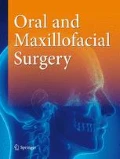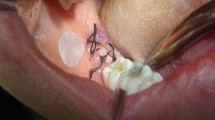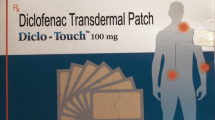Abstract
Purpose
The scope of transdermal analgesics have been limited to pain control following local trauma, muscle spasm, minor esthetic surgeries, or sports-related injuries. Its scope of application can be extended in the field of dentistry and minor oral surgical procedures.
Methods
A total of 40 healthy patients between the age of 18 and 50 years with deeply carious, nontender mandibular molar tooth deemed unsalvageable which was indicated for extraction were taken into study of which subjects were divided into cases and controls.
Results
The data were analyzed with chi-square test and Mann–Whitney U test; the chi-square test showed significant association with expected outcome in visual analog scale pain scores, the two groups at 6th and 12th hour. A Mann–Whitney U test was performed to identify strength of association between two groups where there were significant association between all parameters except for pain interference with routine activities and dental health status(0.022, 0.001); the differences between two groups in these parameters were significant (<0.05).
Conclusion
Transdermal route seems to be comparable to oral diclofenac in post-extraction pain relief; further studies are required to confirm the results and safety for its use in various other dental situations.








Similar content being viewed by others
References
Merskey H, Bogduk N (1994) "Part III: pain terms, a current list with definitions and notes on usage" Classification of chronic pain, 2nd edn. IASP Task Force on Taxonomy, IASP Press, Seattle, pp 209–214
Benini A, DeLeo JA (1999) René Descartes’ physiology of pain. Spine 24(20):2115
Hsieh LF, Hong CZ, Chern SH, Chen CC (2010) Efficacy and side effects of diclofenac patch in treatment of patients with myofascial pain syndrome of the upper trapezius. J Pain Symptom Manage 39(1):116–125, Epub 2009 Oct 12
Predel HG, Koll R, Pabst H, Dieter R, Gallacchi G, Giannetti B et al (2004) Diclofenac patch for topical treatment of acute impact injuries: a randomized, double blind, placebo controlled, multicentre study. Br J Sports Med 38:318–323
Rahimi M, Makarem J (2009) Effects of diclofenac epolamine patch on postoperative sore throat in parturients after cesarean delivery under endotracheal general anesthesia. Acta Anaesthesiol Taiwan 47:17–21
Shugars AD, Benson K, White RP Jr et al (1996) Developing a measure of patient perceptions of short-term outcomes of third molar surgery. J Oral Maxillofac Surg 54:1402–1408
Poeschl PW, Eckel D, Poeschl E (2004) Postoperative prophylactic antibiotic treatment in third molar surgery—a necessity? J Oral Maxillofac Surg 62(1):3–8
Agarwal A, Gautam S, Gupta D, Singh U (2007) Transdermal diclofenac patch vs. eutectic mixture of local anesthetics for venous cannulation pain. Can J Anaesth 54:196–200
Le Louarn C, Buis J, Auclair E (2008) Flectortissugel used to treat capsular contracture after breast augmentation surgery. Aesthet Plast Surg 32:453–458
Barbaud A (2009) Contact dermatitis due to topical drugs. G Ital Dermatol Venereol 144:527–535
Senel E, Ada S, Gulec AT, Caglar B (2008) Nicolau syndrome aggravated by cold application after i.m. diclofenac. J Dermatol 35:18–20
McGee AM, Davison PM (2002) Skin necrosis following injection of non steroidal anti inflammatory drug. Br J Anaesth 88(1):139–140
Devi K, Paranjothy KLK (1999) Pharmacokinetic profile of a new matrix-type transdermal delivery system: diclofenac diethyl ammonium patch. Drug Dev Ind Pharm 25(5):695–700
Biswajit Mukherjee K, SushmitaMahapatra K, Surajit Das B (2005) Sorbitan monolaurate 20 as a potential skin permeation enhancer in transdermal patches. J Appl Res 5(1):96–108
Acknowledgments
The authors would like to declare that there is no conflict of interest in the making of this article. There is no financial interest or association of any of the authors with the various commercial names mentioned in the article.
Author information
Authors and Affiliations
Corresponding author
Rights and permissions
About this article
Cite this article
Krishnan, S., Sharma, P., Sharma, R. et al. Transdermal diclofenac patches for control of post-extraction pain. Pilot randomized controlled double-blind study. Oral Maxillofac Surg 19, 5–12 (2015). https://doi.org/10.1007/s10006-013-0422-5
Received:
Accepted:
Published:
Issue Date:
DOI: https://doi.org/10.1007/s10006-013-0422-5




